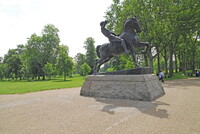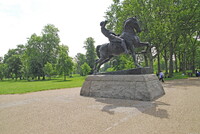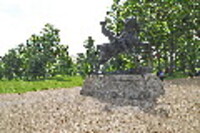| dc.coverage.spatial | Site: London, England, United Kingdom | en_US |
| dc.coverage.temporal | ca. 1870-1902 (creation) | en_US |
| dc.creator | Watts, George Frederick | en_US |
| dc.date | 1870-1902 | en_US |
| dc.date.accessioned | 2013-10-17T19:46:54Z | |
| dc.date.available | 2013-10-17T19:46:54Z | |
| dc.date.issued | 1870-1902 | en_US |
| dc.identifier | 238680 | en_US |
| dc.identifier.other | archrefid: 2611 | en_US |
| dc.identifier.uri | http://hdl.handle.net/1721.3/146449 | |
| dc.description | Context view, side elevation, figure turned away; In the late 1860s Watts turned to sculpture. In 1870, a commission from Hugh Lupus Grosvenor, 3rd Marquess of Westminster (later 1st Duke), for a depiction of his ancestor Hugh Lupus as an equestrian hunter (completed 1884; Eaton Hall, Cheshire) inspired the equally monumental Physical Energy (cast, London, Kensington Gardens), which Watts worked on until the end of his life. The exaggerated musculature and dynamic pose of both horse and naked rider express in symbolic terms the energy Watts saw as characteristic of his age. There is another cast of the work forming the Rhodes Memorial in Cape Town, South Africa, and one in Harare, Zimbabwe. Source: Grove Art Online; http://www.oxfordartonline.com/ (accessed 7/16/2012) | en_US |
| dc.format.medium | bronze | en_US |
| dc.rights | © Scott Gilchrist, Archivision, Inc. | en_US |
| dc.subject | allegory | en_US |
| dc.subject | animal | en_US |
| dc.subject | human figure | en_US |
| dc.subject | horse and rider | en_US |
| dc.subject | horses | en_US |
| dc.subject | Nineteenth century | en_US |
| dc.subject | Symbolist | en_US |
| dc.title | Physical Energy | en_US |
| dc.type | image | en_US |
| dc.rights.access | Licensed for educational and research use by the MIT community only | en_US |
| dc.identifier.vendorcode | 6A1-WGF-PE-A1 | en_US |
| vra.culturalContext | British | en_US |
| vra.technique | casting (process) | en_US |
| vra.worktype | equestrian statue | en_US |
| dc.contributor.display | George Frederick Watts (British sculptor, 1817-1904) | en_US |



